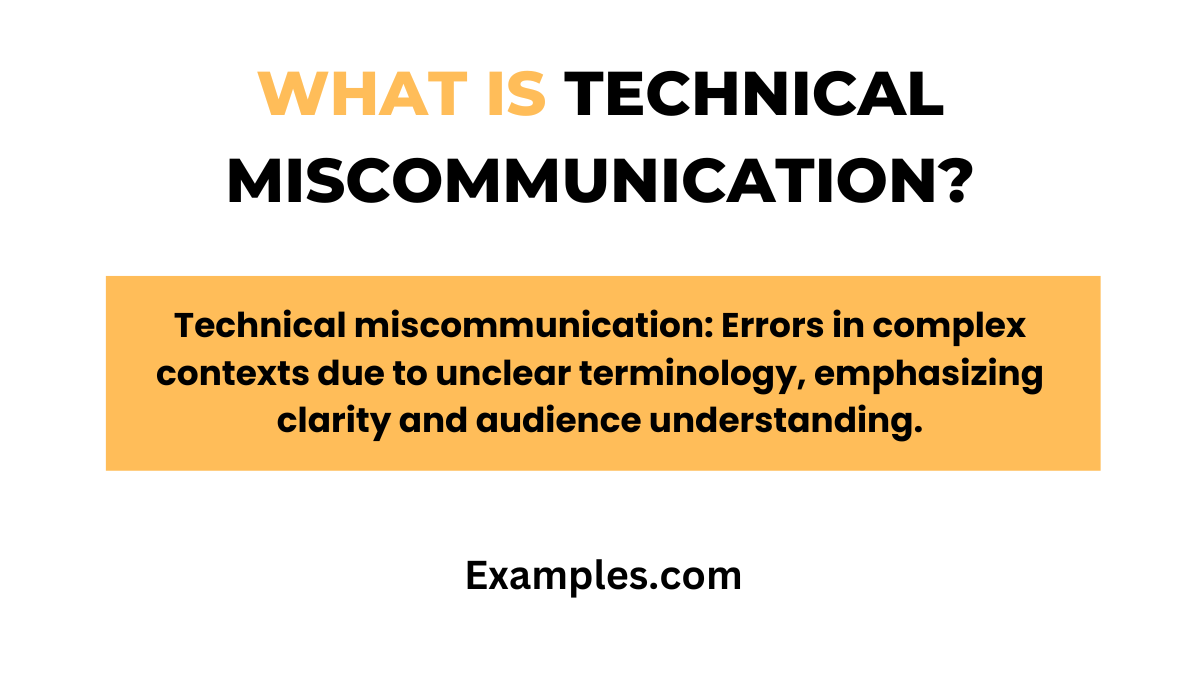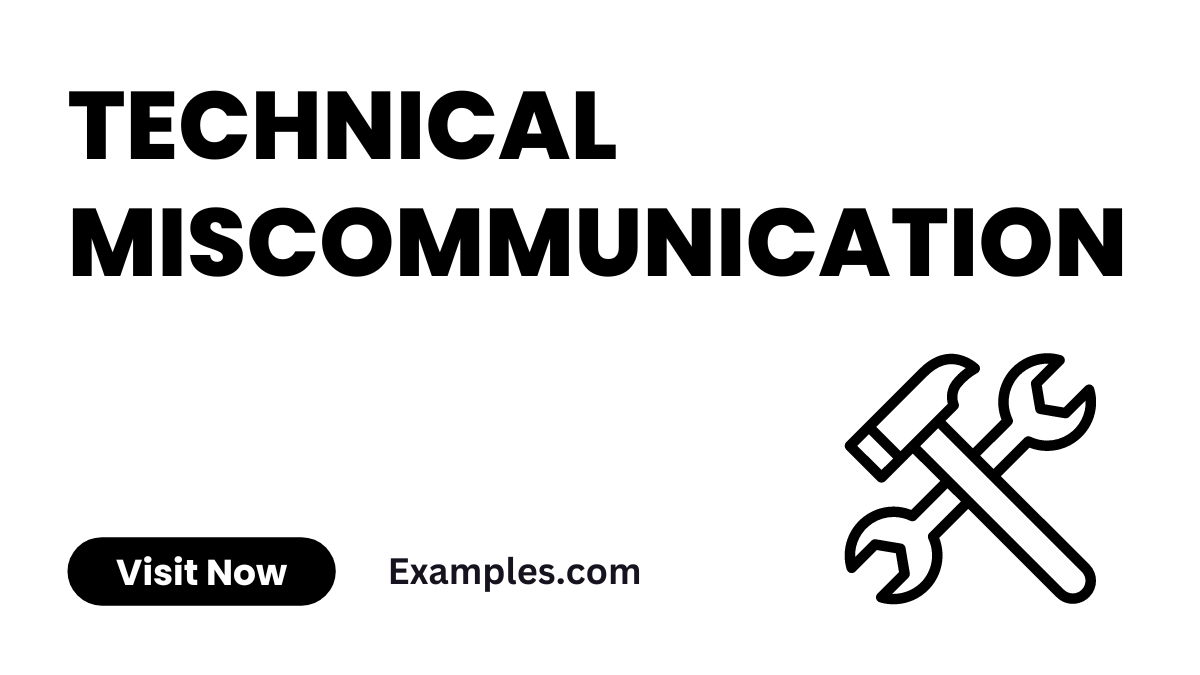24+ Technical Miscommunication Examples
In the intricate realm of technical communication, miscommunication can be a silent disruptor. This guide delves into various miscommunication examples, illustrating how even small misunderstandings can lead to significant setbacks in technical projects. Understanding these examples is crucial for professionals to communicate effectively, avoiding pitfalls and ensuring smooth operations.
What is Technical Miscommunication?

Technical miscommunication occurs when there is a failure to convey or understand information correctly in a technical context. This often involves complex terminology, technical details, or specific processes that are misinterpreted, leading to errors or delays. Clarity, precision, and understanding the audience’s knowledge level are key to preventing such miscommunication.
What is the best Example of Technical Miscommunication?

A classic example of technical miscommunication occurred during the Mars Climate Orbiter mission in 1999. The spacecraft was lost because one engineering team used metric units while another used English units for a key spacecraft operation. This critical misalignment led to the spacecraft deviating from its intended path, resulting in a loss of $125 million and a major setback in space exploration.
25 Technical Miscommunication Examples

Technical miscommunication, a prevalent issue in various industries, occurs when information related to technical aspects is misunderstood or conveyed inaccurately. This can lead to significant complications, particularly in fields like IT, engineering, and scientific research. Ensuring clarity and precision in technical communication is crucial for project success and safety. Here are 25 unique examples of technical miscommunication:
- Incorrect Software Requirements: A developer misinterprets a client’s software needs, leading to an application that doesn’t meet expectations. To avoid this, clearly outline specifications in written form and confirm understanding.
- Engineering Drawing Misinterpretation: An engineer misreads a blueprint, resulting in a structural flaw. Clarify any doubts through detailed discussions and 3D models.
- Medical Dosage Error: A pharmacist misreads a prescription, causing an incorrect medication dosage. Always verify prescriptions through direct communication with the prescribing doctor.
- Misunderstood Technical Jargon: A non-technical stakeholder misunderstands industry-specific terms, leading to incorrect decisions. Use simple language and analogies to explain technical concepts.
- Incorrect Data Interpretation: A researcher misinterprets data, leading to flawed conclusions. Discuss data interpretations in team meetings to ensure accuracy.
- Miscommunication in Software Testing: A tester misunderstands the testing protocol, resulting in incomplete testing. Provide clear, written guidelines for all testing procedures.
- Manufacturing Process Error: A worker misinterprets a process diagram, causing a production error. Utilize step-by-step instructions and hands-on training.
- Faulty Installation Instructions: A technician misreads installation instructions, leading to equipment malfunction. Enhance instructions with visuals and offer support for clarification.
- Network Configuration Mistakes: An IT professional configures a network incorrectly due to unclear guidelines. Use detailed configuration manuals and regular check-ins.
- Misunderstood Project Timeline: A team misinterprets the project timeline, causing delays. Regularly update and clarify timelines in team meetings.
- Laboratory Procedure Error: A lab technician uses the wrong procedure, affecting experiment results. Ensure procedures are written clearly and reviewed regularly.
- Safety Protocol Miscommunication: An employee misunderstands safety instructions, risking workplace safety. Conduct thorough safety training and provide written materials.
- Technical Specification Confusion: A product manager mixes up technical specifications, leading to product defects. Maintain a single, clear document for technical specifications.
- IT Support Misunderstanding: A client misinterprets IT support advice, worsening a technical issue. Offer step-by-step guidance and confirm understanding.
- Construction Material Mix-Up: A contractor uses the wrong materials due to a miscommunication, affecting building integrity. Double-check material lists and specifications with suppliers.
- Software Upgrade Missteps: An IT team misinterprets upgrade instructions, causing system downtime. Conduct pre-upgrade briefings and provide comprehensive guides.
- Electrical Wiring Error: An electrician misunderstands wiring diagrams, leading to potential hazards. Use clear, color-coded diagrams and regular oversight.
- Chemical Handling Mistake: A worker misreads chemical labels, leading to unsafe handling. Implement strict label reading protocols and training.
- Aerospace Engineering Miscommunication: Misinterpretation of design specifications leads to aircraft design flaws. Employ rigorous review processes and model simulations.
- Telecommunication Misunderstanding: An operator configures a communication system incorrectly, impacting connectivity. Use detailed setup guides and technical support.
- Automotive Design Flaw: Miscommunication in design specifications leads to a vehicle recall. Facilitate regular design review meetings and detailed documentation.
- Robotics Programming Error: A programmer misunderstands the coding requirements, affecting robot functionality. Conduct code reviews and provide clear programming guidelines.
- Environmental Testing Oversight: Misinterpretation of testing protocols leads to incorrect environmental impact assessments. Standardize testing procedures and conduct regular training.
- Energy System Misconfiguration: Incorrect interpretation of energy system requirements leads to inefficiency. Use detailed schematics and regular technical meetings.
- Software Integration Misunderstanding: A team misinterprets integration requirements, leading to compatibility issues. Outline integration steps clearly and verify through regular updates.
Each example illustrates the importance of precise communication in technical fields. By enhancing clarity and confirming understanding, many of these issues can be mitigated, ensuring smoother project progression and increased safety.
Technical Miscommunication in the Workplace
- Inconsistent Terminology: Different departments using varied technical jargon can lead to misinterpretation. For example, IT and marketing teams may have different understandings of ‘engagement metrics’.
- Complex Instructions: Overly technical instructions can confuse team members. An IT specialist’s detailed coding instructions might be perplexing to non-technical staff.
- Assuming Technical Knowledge: Assuming all team members have the same level of technical know-how can lead to misunderstandings. For instance, not everyone may be familiar with advanced software features.
- Lack of Context: Providing technical information without adequate context can lead to miscommunication. For example, discussing server requirements without explaining their impact on project timelines.
- Overuse of Acronyms: Excessive use of acronyms can alienate team members who aren’t familiar with them, like using ‘API’ without explaining it means Application Programming Interface.
- Email Misinterpretation: Technical details can be misinterpreted in emails due to lack of tone and immediate clarification. For instance, an email about system updates can be misunderstood if not clearly explained.
- Cultural Differences: Cultural differences in communication can lead to technical miscommunication, such as varying interpretations of urgency in addressing technical issues.
How to Avoid Technical Miscommunication
- Standardize Terminology: Develop a glossary of terms to ensure everyone has the same understanding. For instance, clearly defining what ‘bandwidth’ means in different contexts.
- Simplify Communication: Break down technical concepts into simpler language. Use analogies to explain complex technical ideas, like comparing cloud computing to a utility service.
- Regular Training: Conduct regular training sessions to enhance the team’s technical literacy. For example, workshops on the latest software tools.
- Provide Context: Always give the background and rationale for technical decisions. Explain why certain technical routes are chosen, like opting for a particular software solution.
- Limit Jargon and Acronyms: Use plain language and explain acronyms when necessary. For instance, spell out ‘SEO’ as Search Engine Optimization the first time it’s used.
- Effective Email Communication: Be clear and concise in emails. Use bullet points for technical specifications to enhance readability.
- Encourage Questions: Create an environment where asking for clarification is encouraged. This helps clear up any technical misunderstandings immediately.
- Use Visual Aids: Diagrams and flowcharts can help explain complex technical processes, like network infrastructures.
Technical miscommunication can significantly impact workplace efficiency and project outcomes. By simplifying communication, standardizing terminology, encouraging questions, and using visual aids, organizations can effectively reduce these misunderstandings. Regular training and cultural sensitivity are also crucial in fostering clear and effective technical communication.



